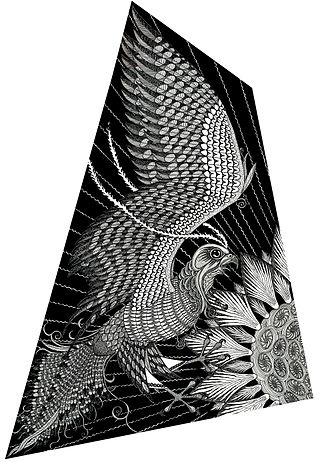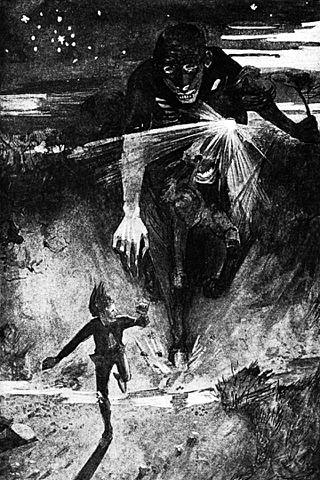Finnish mythology commonly refers of the folklore of Finnish paganism, of which a modern revival is practiced by a small percentage of the Finnish people. It has many shared features with Estonian and other Finnic mythologies, but also with neighbouring Baltic, Slavic and, to a lesser extent, Norse mythologies.
Hiisi is a term in Finnic mythologies, originally denoting sacred localities and later on various types of mythological entities.
Lempo is a sort of fiend from Finnish folklore and mythology. Lempo is the god of love and fertility in Finnish mythology.

The bogeyman is a mythical creature used by adults to frighten children into good behaviour. Bogeymen have no specific appearances and conceptions vary drastically by household and culture, but they are most commonly depicted as masculine or androgynous monsters that punish children for misbehaviour. The bogeyman, and conceptually similar monsters can be found in many cultures around the world. Bogeymen may target a specific act or general misbehaviour, depending on the purpose of invoking the figure, often on the basis of a warning from an authority figure to a child. The term is sometimes used as a non-specific personification of, or metonym for, terror, and sometimes the Devil.

In Slavic mythology, the Raróg or Raróh is a fire demon, often depicted as a fiery falcon.
Enchantress most commonly refers to:
Estonian mythology is a complex of myths belonging to the Estonian folk heritage and literary mythology. Information about the pre-Christian and medieval Estonian mythology is scattered in historical chronicles, travellers' accounts and in ecclesiastical registers. Systematic recordings of Estonian folklore started in the 19th century. Pre-Christian Estonian deities may have included a god known as Jumal or Taevataat in Estonian, corresponding to Jumala in Finnish, and Jumo in Mari.

A mare is a malicious entity in Germanic and Slavic folklore that walks on people's chests while they sleep, bringing on nightmares.

The nuckelavee or nuckalavee is a horse-like demon from Orcadian folklore that combines equine and human elements. British folklorist Katharine Briggs called it "the nastiest" of all the demons of Scotland's Northern Isles. The nuckelavee's breath was thought to wilt crops and sicken livestock, and the creature was held responsible for droughts and epidemics on land despite being predominantly a sea-dweller.
Kaleva – also known as Kalevi or Kalev – and his sons are important heroic figures in Estonian, Finnish and Karelian mythology. In the Finnish epic the Kalevala, he is an ancient Finnish ruler. In Estonian mythology and Friedrich Reinhold Kreutzwald's epic poem Kalevipoeg, King Kalev was the father of King Kalevipoeg and the husband of Linda.
Mythic humanoids are legendary, folkloric, or mythological creatures that are part human, or that resemble humans through appearance or character. Each culture has different mythical creatures that come from many different origins, and many of these creatures are humanoids. They are often able to talk and in many stories they guide the hero on their journey.

European folklore or Western folklore refers to the folklore of the Western world, especially when discussed comparatively. The history of Christendom during the Early Modern period has resulted in a number of traditions that are shared in many European ethnic and regional cultures.
Elements of a Proto-Uralic religion can be recovered from reconstructions of the Proto-Uralic language.

Folklore of Finland refers to traditional and folk practices, technologies, beliefs, knowledge, attitudes and habits in Finland. Finnish folk tradition includes in a broad sense all Finnish traditional folk culture. Folklore is not new, commercial or foreign contemporary culture, or the so-called "high culture". In particular, rural traditions have been considered in Finland as folklore.





